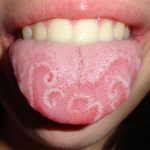 A chronic condition characterized by desquamation of the superficial epithelium of the dorsum of the tongue, which migrates continuously.
A chronic condition characterized by desquamation of the superficial epithelium of the dorsum of the tongue, which migrates continuously.
Geographic tongue is a term applied to a map-like appearance of the tongue resulting from irregular bare patches on its surface. This patchy form of glossitis (loss of papillae causing the tongue to appear smooth) changes location and appearance from day to day. It is a benign condition but can be persistent. This disorder is often self-limiting and does not require treatment. The causes of geographic tongue are unknown, although allergies or local irritants such as hot, spicy food may be involved. It is also possible that this condition may be a reaction to stress. Geographic tongue may also be known as benign migratory glossitis.
A condition producing a map-like appearance on the tongue due to the breakdown of papilla (tiny surface cell projection that coats the tongue) producing smooth, dark or bright red patches with sharp, raised margins on some areas on the tongue’s surface. There may also be deep crevices on the tongue. These patches may change from day to day or remain the same. They may intermittently disappear and then recur. Causes of the condition are unclear. A person who has geographic tongue usually does not have any symptoms but may find contact with certain foods or substances mildly painful. Even toothpaste can cause soreness. Although uncomfortable, the condition is considered harmless. No specific treatment is available, but avoiding spicy foods, hot foods and beverages, alcohol, and tobacco can help prevent discomfort.
A tongue with white raised areas, normal epithelium, and atrophic regions. This condition is also known as benign migratory glossitis.
